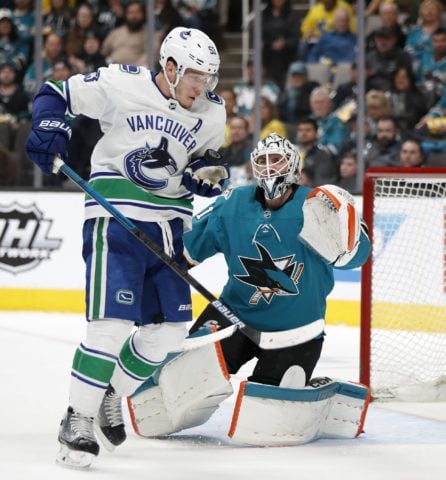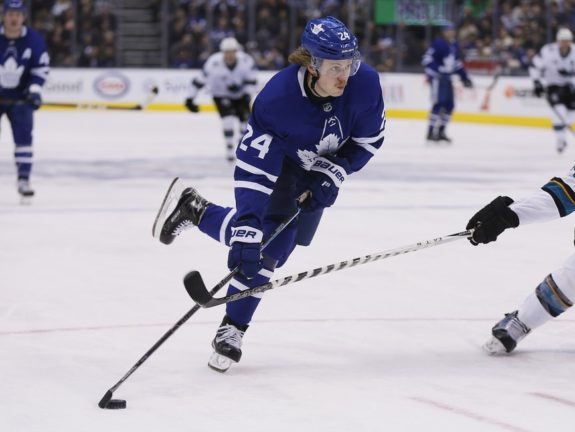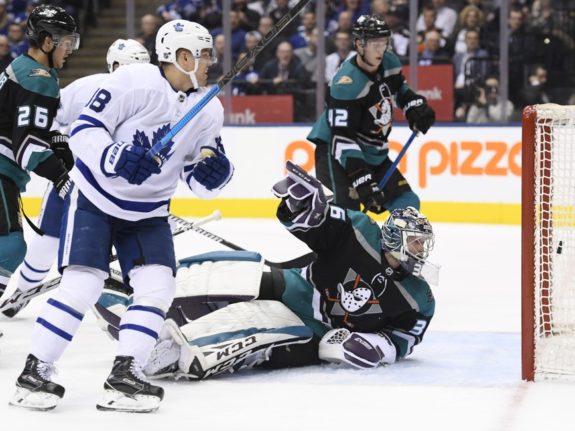It’s no secret Bo Horvat’s revolving door of wingers has been a problem for the Vancouver Canucks this season.
The club’s promising 23-year-old centre has played at least 100 minutes with 10 different wingers at 5-on-5 so far in 2018-19.
- Brock Boeser: 296:01
- Antoine Roussel: 251:36
- Jake Virtanen: 249:40
- Nikolay Goldobin: 235:42
- Loui Eriksson: 218:37
- Sven Baertschi: 137:46
- Josh Leivo: 130:43
- Tyler Motte: 107:40
- Tim Schaller: 107:13
- Markus Granlund: 104:49
Given the circumstances, Horvat has done extremely well for himself, establishing a new career-high of 23 goals through 68 games (13 at 5-on-5), and putting himself on pace for a career-best 59 points.

Of the 10 wingers listed above, few inspire confidence in a top-six role alongside Horvat long-term. Only Boeser has more than 10 goals at 5-on-5 this season, but clearly, he is slated to play with rookie sensation Elias Pettersson. Roussel has played well this year but is better suited for third-line duty. Virtanen has potential, but again, doesn’t he fit better on the third line? As for Goldobin, seven goals in 58 games does not scream top-six to me, regardless of his questionable lineup usage by head coach Travis Green.
So, the question becomes: how do the Canucks fix this?
One of the names above appears to be half the solution. Since coming over from the Toronto Maple Leafs in December, Leivo has scored eight goals in 35 games at 5-on-5. His 1.16 goals per 60 minutes (G/60) rate this season is first on the Canucks, even ahead of Pettersson, and ranks inside the top-30 in the NHL for skaters with at least 400 minutes played. And at 25 years old, he’s not on the decline. It’s a small sample, sure, but Leivo isn’t a bad option right now based on the alternatives.
As for the second half of the ‘Horvat winger solution,’ I think the Canucks need to get a little creative. Or, at least try to. No, they can’t bank on convincing a big-name free-agent like Artemi Panarin to join their ranks. It’s just not going to happen (he’s bound for Florida or New York almost certainly).
Instead, this summer, the Canucks should offer sheet Toronto Maple Leafs winger Kasperi Kapanen or teammate Andreas Johnsson.
Related: Canucks Need to Be Careful With Edler Extension
Why Target Kapanen or Johnsson?
Kapanen is just 22-years-old and has 19 goals and 42 points in 67 games this season, despite skating just 16:32 per game. He is a superb penalty killer too, due to his blazing speed. Kapanen’s 0.85 G/60 rank fourth on the high-flying Maple Leafs in 2018-19, a team that leads the NHL in even-strength goals for.
Johnsson, 24, also has 19 goals this season, but he’s done so in a surprisingly small amount of minutes, skating just 13:10 per game (10th of Leaf forwards). His speed is also a great asset and his 1.32 G/60 rank 10th in the entire NHL for skaters with at least 600 minutes played.

Suffice to say, both these players are quite good: they’re young, fast and built for today’s game. They would both do swimmingly on Horvat’s wing. But the real reason they are ripe for the taking is because they are both restricted free-agents on a team that is facing a serious cap crunch this summer.
How Much Would Kapanen or Johnsson Cost?
On Monday, hockey analyst Ray Ferraro said on TSN 1040 he doesn’t think it would cost that much to offer sheet Kapanen or Johnsson because of the Maple Leafs cap situation.
“I would be interested in both and I think the Leafs are a little unsure or a little nervous about both of them too,” Ferraro said. “Eventually you’re not going to have enough money. So for the Leafs…the nervousness would be, ‘What if somebody targets one of these guys that we sure as heck don’t want to lose, but we can’t do much about it?”
Related: Canucks Gaudette Deserves Bigger Role
How cap strapped are the Maple Leafs? Currently, they have $68.1 million tied up in 16 players for the 2019-20 season (this figure is when they move Nathan Horton’s $5.3 million cap hit to long-term injured reserve once again). That leaves them $14.9 million left over to sign seven players (in order to get to a 23-man roster). RFA Mitch Marner will take up roughly $10 million of that on his own.
This is why Ferraro said it wouldn’t be necessary to offer ‘crazy money’, when co-host Blake Price asked the former 18-year NHL veteran if he would offer somewhere around $6.5 million per season for Kapanen.
You don’t have to go $6.5 million, I don’t think Blake. The [Maple Leafs] have some cap stress anyway. You’ve gotta get into some pretty significant money before it’s crazy [compensation] — the draft picks that go back. I believe just over $4 million is a second-round pick…but the answer is yes [I would offer sheet him]. And the reason the answer is yes is these are young players that are very good. If you’re sitting there and saying “I’m not going to RFA offer sheet anybody,” you’re not doing your job. It’s part of the CBA. Look at it. Look at the list of players that are RFA this year. There are teams that have significant cap crunches that are hoping to heck that somebody doesn’t [offer sheet] their guy.
In early February, TSN hockey insider Bob McKenzie estimated next year’s Maple Leafs payroll, which included them retaining Johnsson and Kapanen for quite cheap. Under his projection, Kapanen would re-sign with the Leafs, presumably on a bridge deal, for just $2.75 million per season, while Johnsson’s new deal would be $500,000 less than that per season.
Here's @TSNBobMcKenzie's projected 19-20 Leafs roster. pic.twitter.com/qxRSmx4Yvs
— Platinum Seat Ghosts (@3rdPeriodSuits) February 5, 2019
So, if you’re the Canucks, how high do you go to entice them to come out west?
Well, Ferraro was basically bang-on with his compensation package. If the Canucks offer between $2,029,660 and $4,059,322 and either player signs, the club only surrenders one second-round pick to the Maple Leafs. Obviously, it’s worth it to go as high as you can without passing that threshold. So $4.059 million per season seems about right. If someone signs for between $4,059,323 and $6,088,980, the compensation is a first-round pick and a third-round pick. That Canucks first-rounder isn’t going anywhere, not with the draft being held in Vancouver (the draft picks must be available in the nearest entry draft).
The not great news is the surrendered pick also has to be their own selection, not one they’ve acquired from another team. But if it’s just one second, isn’t it worth it for a potential 30-goal scorer with blazing speed who can kill penalties and is only in his mid-20s? That would be highway robbery, even if it’s only for a couple seasons (a long-term deal is unlikely if it’s only $4 million).
No Downside to Attempting an Offer Sheet
Back to Ferraro, because nine times out of 10, he has the correct take. Let’s say the Maple Leafs match the offer sheet. It’s still better than not offering it in the first place because now they’re in a worse situation cap-wise: they have to eat up more of their cap to keep their young wingers.

What’s the worst-case scenario? That would be this strange notion in hockey circles that the other team will ‘get you back’ if you offer sheet their player.
“This whole thing about ‘Oh, if I do it, somebody is going to get back at me,’ so what? It’s the way the game is,” Ferraro said. “Be aggressive. Because sitting around and signing 32-year-old players isn’t getting it done.”
In this situation, the only notable RFAs the Canucks have are Boeser and Leivo. The Maple Leafs, as mentioned, don’t have any cap room anyway. That means they can’t really target one of those players ‘in retaliation’, unless it was a very small amount, which the Canucks would quickly match.
The last thing to keep in mind is if Kapanen or Johnsson would even want to sign an offer sheet with the Canucks. It’s quite possible they wouldn’t. But if you were offered $1-1.5 million more per season, it would be hard to turn down. The fact is, the Canucks won’t know if they don’t try.
In this case, it’s clearly worth it because if it works, it would expedite the rebuild by adding another top-six winger. If it doesn’t work, you’re still screwing over the Maple Leafs just a little bit. Isn’t that alone enough?